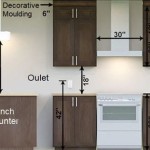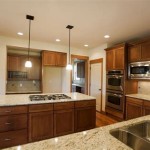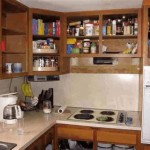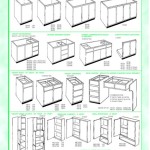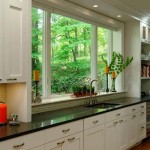What Color Walls Go With Dark Gray Cabinets
Dark gray cabinets have become a popular choice in modern interior design, offering a sophisticated and versatile foundation for various design styles. Their deep hue provides a grounding element, contrasting beautifully with lighter elements and creating a dramatic effect in kitchens, bathrooms, and other spaces. Selecting the right wall color to complement dark gray cabinets is crucial for achieving a balanced and aesthetically pleasing environment. The choice depends on several factors, including the desired mood, the amount of natural light in the room, and the other design elements present, such as flooring, countertops, and hardware.
The undertones of the dark gray cabinets also play a significant role in determining the ideal wall color. Some dark grays lean towards a cooler, blue-gray hue, while others have warmer, more brown-gray undertones. Understanding these subtle differences is essential for creating a harmonious color palette. Furthermore, considering the function of the room and personal preferences is essential to inform the final decision. A bright, airy feel might be desired in a kitchen, while a more cozy and relaxing atmosphere could be the goal in a bathroom.
Understanding the Undertones of Dark Gray
Dark gray is not a monolithic color; it exists on a spectrum with varying undertones. These undertones profoundly influence how the gray interacts with other colors in a space. Identifying whether the dark gray leans towards cool or warm undertones is the first step in selecting a complementary wall color.
Cool grays often contain hints of blue, green, or purple. These undertones create a sense of calmness and sophistication. When working with cool grays, wall colors that share similar cool undertones, such as light blues, greens, or even lavender, can create a cohesive and harmonious look. Alternatively, contrasting warm colors, like creamy yellows or soft peaches, can create a balanced and visually interesting contrast. However, caution should be exercised when pairing cool grays with certain warmer shades, as some combinations might clash or feel unbalanced.
Warm grays, on the other hand, possess undertones of brown, beige, or even hints of red. These warmer hues lend a sense of comfort and earthiness to the space. Wall colors that complement warm grays include off-whites with warm undertones, earthy greens, and muted oranges. These colors enhance the warmth of the gray and create a welcoming atmosphere. Conversely, pairing warm grays with stark, cool whites can sometimes result in a sterile or less inviting feel. It is essential to consider the intensity and saturation of the wall color when pairing it with warm grays, as overly bright or saturated colors can overwhelm the subtle warmth of the cabinets.
The best way to determine the undertones of dark gray cabinets is to compare them to other gray samples with known undertones under natural light. Holding the cabinet sample next to a pure white surface can also help reveal the underlying hues. This careful analysis will guide the selection process and ensure a successful color combination.
Popular Wall Color Choices for Dark Gray Cabinets
Several wall colors consistently prove to be successful pairings with dark gray cabinets, each offering a distinct aesthetic. While personal preference is paramount, these established combinations provide a solid foundation for exploring different design possibilities.
White and Off-White: A classic and timeless choice, white walls provide a crisp and clean backdrop that allows the dark gray cabinets to stand out as a focal point. The contrast between the light walls and dark cabinets creates a visually striking effect, making the space feel brighter and more open. Off-white variations, such as creamy whites or warm whites, can soften the contrast and add a touch of warmth to the overall design. The specific shade of white should be chosen based on the undertones of the gray cabinets. Cool grays pair well with brighter, cooler whites, while warm grays benefit from the subtle warmth of off-white hues.
Light Gray: Creating a monochromatic scheme with light gray walls offers a sophisticated and minimalist look. This approach works particularly well when the light gray has similar undertones to the dark gray cabinets, ensuring a cohesive and harmonious palette. To prevent the space from feeling too flat or monotonous, consider incorporating different textures and finishes to add depth and visual interest. For example, textured wallpaper or different sheens of paint can create subtle variations that enhance the overall design.
Blue and Green Tones: Cool-toned blues and greens can create a calming and serene atmosphere when paired with dark gray cabinets. Light blues, such as sky blue or pale blue-gray, evoke a sense of tranquility and openness, while deeper blues, like navy or teal, add depth and drama. Similarly, soft greens, such as sage green or mint green, bring a touch of nature indoors and create a refreshing ambiance. Consider the intensity of the color and the amount of natural light in the room when selecting a blue or green hue. Lighter shades are ideal for smaller spaces with limited natural light, while deeper shades can work well in larger, well-lit rooms.
Warm Neutrals: For those seeking a warmer and more inviting aesthetic, warm neutrals like beige, taupe, or greige (a blend of gray and beige) can provide a comforting backdrop for dark gray cabinets. These colors create a sense of warmth and earthiness, making the space feel cozy and welcoming. Warm neutrals are particularly well-suited for kitchens and bathrooms, where a sense of comfort and relaxation is desired. It is essential to choose a warm neutral that complements the undertones of the gray cabinets. For example, a beige with pink undertones might clash with a cool gray, while a taupe with brown undertones would create a more harmonious pairing.
Factors Influencing Wall Color Selection
Beyond undertones and popular color choices, several factors can influence the optimal wall color selection for spaces featuring dark gray cabinets. These considerations ensure that the chosen color complements the overall design and enhances the functionality and appeal of the room.
Natural Light: The amount of natural light in a room significantly impacts how colors appear. In rooms with ample natural light, darker wall colors can be used without making the space feel cramped or gloomy. However, in rooms with limited natural light, lighter wall colors are generally preferred to maximize brightness and create a more open feel. When working with dark gray cabinets in a dimly lit space, consider using a light-reflecting paint finish, such as semi-gloss or gloss, to bounce light around the room. Alternatively, incorporating strategic lighting fixtures can help brighten the space and compensate for the lack of natural light.
Room Size: The size of the room also influences the choice of wall color. In smaller rooms, lighter colors are generally recommended to create an illusion of spaciousness. Darker colors can make a small room feel even smaller and more enclosed. However, if a dramatic and cozy atmosphere is desired, a darker wall color can be used strategically on a single accent wall to add depth and visual interest without overwhelming the space. In larger rooms, both light and dark wall colors can be used effectively, depending on the desired mood and the overall design scheme.
Flooring and Countertops: The colors and materials of the flooring and countertops should also be considered when selecting a wall color. The goal is to create a cohesive and harmonious palette that ties all the elements of the room together. For example, if the flooring is a warm wood tone, a warm neutral wall color or a soft green can complement the wood and create a welcoming atmosphere. If the countertops are a cool-toned marble, a light gray or a cool blue wall color can enhance the marble's beauty and create a sophisticated look. Consider the overall style of the room when making these decisions. For a modern aesthetic, a minimalist color palette with clean lines might be preferred, while a more traditional style might call for warmer and more layered colors and textures.
Personal Preference and Style: Ultimately, the best wall color for dark gray cabinets is the one that reflects personal preferences and complements the overall style of the home. Consider the desired mood and atmosphere you want to create, and choose colors that evoke those feelings. Experiment with different color combinations and paint samples to find the perfect match. Don't be afraid to step outside of traditional color palettes and explore unconventional choices that express your unique personality. The most important factor is that you love the way the space looks and feels.
Selecting the precise shade requires careful consideration. Paint stores offer a range of color swatches that can be brought home and tested in the specific lighting conditions of the room. Painting large swatches of different colors on the wall and observing them at different times of day will provide a more accurate representation of how the colors will appear in the finished space. This process allows for adjustments to be made based on the interplay of light, cabinet color, and other design elements. This careful evaluation will yield a result that is both visually appealing and personally satisfying.

Great Gray Kitchen Ideas When Redesigning Your Home Aco

50 Gorgeous Gray Kitchens That Usher In Trendy Refinement Grey Kitchen Designs Cabinet Design Modern Remodel
:max_bytes(150000):strip_icc()/Oak-kitchen-cabinets-painted-with-Benjamin-Moore-Chelsea-Gray-Mineral-Jet-formica-countertops-and-Gentle-Cream-walls-1024x640-5b356a2146e0fb0054aeb742.jpg?strip=all)
20 Ways To Style Gray Kitchen Cabinets

Gray Kitchen Cabinets That Ramp Up The Style Factor In Your Home

Gray Kitchen Cabinets The Right Amount Of Color Sweeten

11 Ideas For Dark Kitchen Cabinets Paintzen

12 Wall Colors That Go With Gray Kitchen Cabinets Hunker

12 Wall Colors That Go With Gray Kitchen Cabinets Hunker

The Perfect Shades Of Gray

Grey Kitchen Ideas Designers Explain How To Use This Color
Related Posts

